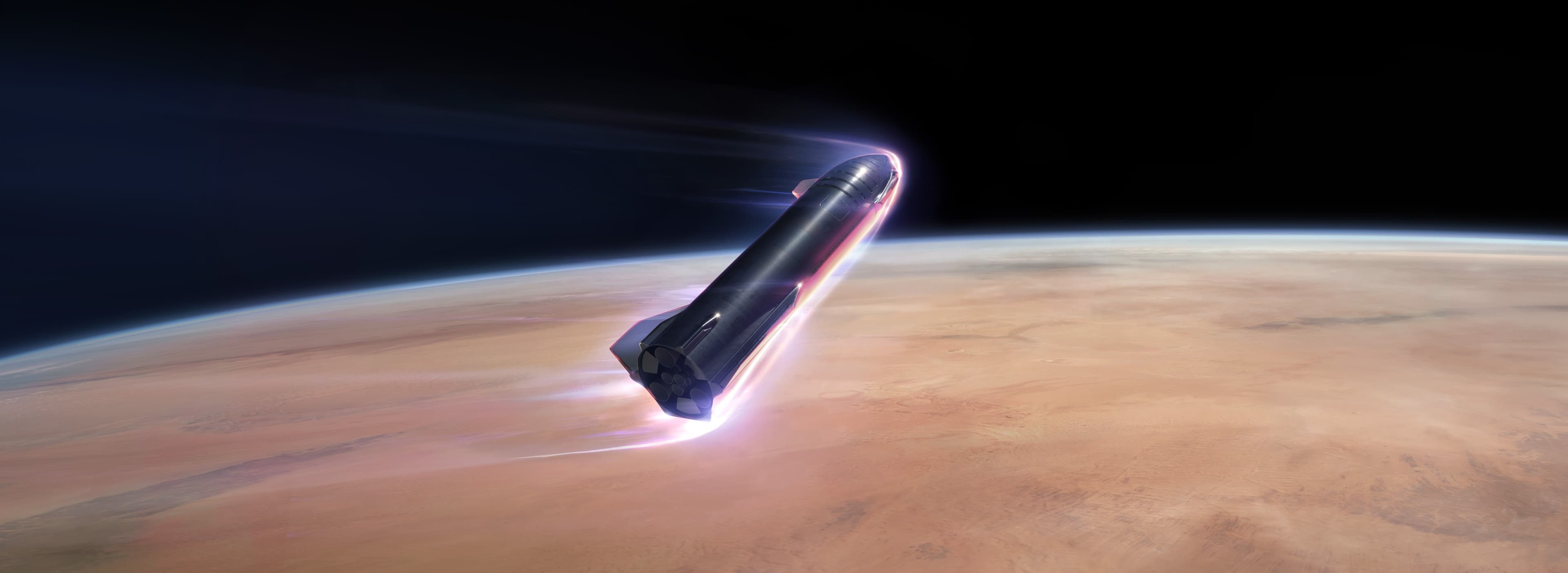Starship
Reading Time: minute
Audiobook: Not available for this chapter

This bad boy is supposed to be the flagship of human space exploration for a while now, huh?
Let's give it a closer look.
Fundamentals
SpaceX' Starship spacecraft and the Super Heavy Booster represent a fully and rapidly reusable transportation system designed to carry both crew and cargo to the Moon, Mars and beyond. I did great copy-pasting that from their website, did I? Jokes aside now.
History
The development of the Starship began around 2012, although it was first mentioned by SpaceX in 2010 during a meeting at the AIAA - the American Institute of Aeronautics and Astronautics, where they also revealed they would be working on bigger engines than their previous Merlin systems that powered the Falcon 1 and 9. Back then, SpaceX imagined they would plan on and develop two seperate rocket engines for the lower and upper stage of Starship. The lower one, they referenced it by the name "Merlin 2", was supposed to run on RP-1 as fuel and the upper one was actually called the Raptor engine similar to the one they developed recently but was supposed to run on LH2 (liquid hydrogen).
As we know now and discussed earlier in the Rocket Engines (opens in a new tab) section, Starship ultimately ended up using the same engine - the Raptor engine - for both the booster and the Starship itself and both of them use methane as fuel instead of RP-1 and liquid hydrogen. Actually, as you might also remember, the full flow staged combustion cycle utilized by the Raptor engine wouldn't even be possible to achieve with RP-1!
Early Marks
SpaceX's Starship program has undergone numerous testing and development phases.
Prototypes Mk1 and Mk2 were built and tested in Texas and Florida, respectively, and featured three Raptor engines with the capability to reach an altitude of 5km. Starship SN1 underwent successful pressurization tests in Boca Chica, but it was destroyed during a cryogenic pressurization test. SN3 and SN4 were destroyed during testing in April and May 2020. SN5 and SN6 underwent testing and flew up to 150m.
High-altitude test flights with SN8 and SN9 were mostly successful, but they crashed on landing due to low pressure in the methane header tank and the failure of one of the engines' oxygen pre-burner. SN10 successfully completed a cryogenic proof test and two static fire tests in February 2021. It attempted two launches in March, but the first was aborted due to an engine issue and the second resulted in a hard landing and explosion. SN11 underwent a cryogenic proof test and three static fire tests before a flight test on March 30, which ended in a mid-air explosion. SN12 through SN14 never launched, and SN16 through SN19 were either scrapped or never completed.
As you can see in the video below, SN15 however featured several improvements, including updated software, propellant architecture, and Raptor design.
It completed several tests before conducting a successful 10 km flight test and landing in May 2021. It was subsequently retired and added to the Rocket Garden. The following prototypes were either not completed or scrapped up to SN24.
Ship 24, as of December 2022, was planned to make an orbital test flight atop Booster 7. It underwent several tests, including cryogenic proof tests, spin prime tests, and static fire tests, before being stacked on top of Booster 7. On April 20, 2023, it finally had it's first integrated flight test. After a successful liftoff however, it failed at stage seperation and was subsequently destroyed by the Flight Termination System to prevent damage on potential ground collision.
Future Outlook
In 2024, SpaceX dearMoon program plans to send 9 civilians on a journey around the moon in one of their Starships. One of these civilians is Yusaku Maezawa, a japanese billionaire who's also funding the project.
Shortly after this project and after conducting more integrated flight tests, first cargo rockets are planned to be sent to Mars to establish a baseline of materials, life support systems and infrastructure for the first manned mars mission.
Additional Resources
- You can learn more about Starship on the official SpaceX website as they have a subpage for it.